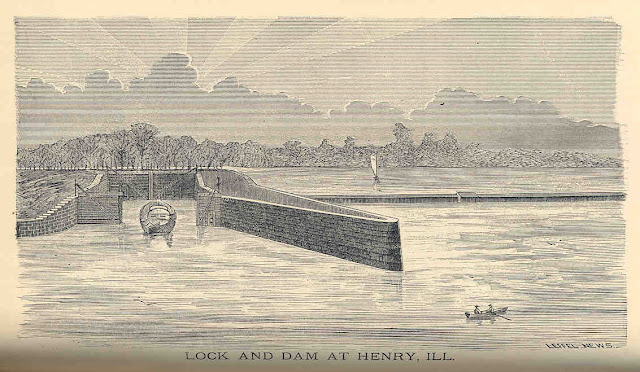1870 Bridge: (Bridge Hunter)
1935+1988 Bridge: (Bridge Hunter; Historic Bridges; John A. Weeks III; Satellite)
 |
| Terry Baker posted
Part of the old locks and dam at Henry IL Purpose? It sure has a good look.
Kerry Doyle Looks similar to the housing for a gauging station, which would report water height and flow.Rob Smith Yes. And since the Peoria Pool is so long ( 74 river miles ) and an elevation difference of 18 feet along that distance.... Commercial mariners keep a pretty close eye on the gage there during rising or falling river events. It is approximately halfway between Peoria and Starved Rock. Dennis DeBruler I learned that "right bank" is from the perspective of a boat going downstream. https://rivergages.mvr.usace.army.mil/.../stationinfo2... Learning about an abandoned lock is fascinating. Dennis DeBruler "This lock here is the largest and most complete of any on this continent. Twelve canal boats can be taken through at one lockage. The gates, four in number, are wonderfully ponderous in their dimensions, each gate being forty-three feet wide, and twenty-four feet high, and containing 25,000 feet of lumber, and ten tons of iron, and yet their construction and machinery are such that two men can handle them easily." http://genealogytrails.com/.../mar.../history/HenryLock.html |
 |
| Satellite |
 |
| Dennis DeBruler commented on Terry's post Several web sites have copies of this postcard. This was the first lock and dam on the Illinois River. https://www.cityofhenryil.org/history-of-locks-dam-and... |
 |
| A colorization of the above |
 |
| James Leffel & Co. / Public domain |
 |
| LandmarkHunter The lock and dam was built to extend the navigation season to improve the utilization of the I&M Canal. |
 |
| Art Kistler, IDOT photographer, 1931 via Bridge Hunter Henry Bridge, 1931 |
 |
| Gene Smania 1988 via Bridge Hunter, License: Released into public domain Look upstream |
 |
| Street View [The trees on the right hide two more spans over the flood plain.] |
 |
| Art Kistler, IDOT photographer, 1935 via Bridge Hunter |
 |
| John A. Weeks III Prior to 1870, the Illinois river was shallow enough in the area of Henry that horse and buggy traffic could ford the river most of the year. This was convenient for land travelers, but it made river navigation all but impossible. To solve the river navigation problem, the Henry Lock & Dam was built, opening in 1870. The lock and dam project cost $400,000. It was the first lock and dam structure on the Illinois River. While the lock and dam was successful, it raised the water level of the river high enough that it could no longer be forded. As a result, a new wood and iron bridge with a swing span was built between 1867 and 1870. It was designed for horse and carriage traffic. |
 |
| John A. Weeks III |
 |
| Rodney LeQuia posted Chris Murphy: Definitely Henry bridge lol old Henry lock there on the right descending side. First lock and dam built on the IL river back in 1870. Joe DeSmit: Channel markers in wrong spot lol. Steven Hearn: 2 of 1000’s of stray buoys that are out there. Coast Guard used to pay to get them back, |
 |
| Bruce Congdon posted Brad Bennick S/B at Henry Il. |
 |
| CityOfHentryIL After many years of carrying traffic across the Illinois River, the bridge again was closed in 1988. Construction crews worked night and day to repair the vital link between Putnam County on the east side of the river and the Henry community on the west. Traffic was rerouted to surrounding communities. School buses customized their routes to provide continued service to the students. |
The race between Illinois and Kentucky to see who can destroy all of their truss bridges first is still on.
Henry Bridge
Sadly, IDOT has now announced plans to replace this truss bridge as well. Plan to replace with a new bridge by 2025. Probably a UCEB in the works. Fewer truss bridges over the Illinois with each passing year.
https://www.pjstar.com/news/20191027/gateway-bridge-into-hen...
https://www.pjstar.com/news/20191027/gateway-bridge-into-hen...
I wondered if the green spot in the river off the east bank was a remnant of the dam.
 |
| Satellite |
So I fired up Global Earth to look at the area with different river levels, and I concluded that it is just a high spot on a sand bar.


No comments:
Post a Comment